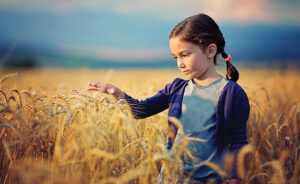 Richard Louv’s “Last Child in the Woods” decries the fact that today’s children spend less and less time outdoors in continually limited spaces. When they are outside, it tends to be in regulated activities such as sports. Children are constantly being told “don’t get dirty” or “be careful.” This month we will observe a holiday that sends us outdoors to look and be in nature. Tu B’shvat, celebrated this month on the 11th, celebrates trees. The holiday began for the practical reason that there are commandments in the Torah that require us to know the age of a tree. Just as horses all become a year older on January 1st, trees all become a year older on Tu B’shvat.
Richard Louv’s “Last Child in the Woods” decries the fact that today’s children spend less and less time outdoors in continually limited spaces. When they are outside, it tends to be in regulated activities such as sports. Children are constantly being told “don’t get dirty” or “be careful.” This month we will observe a holiday that sends us outdoors to look and be in nature. Tu B’shvat, celebrated this month on the 11th, celebrates trees. The holiday began for the practical reason that there are commandments in the Torah that require us to know the age of a tree. Just as horses all become a year older on January 1st, trees all become a year older on Tu B’shvat.
When I was growing up, we celebrated this holiday by slipping coins into cardboard slots until we had enough to plant a tree In Israel, handed carob pods which were somehow linked to Israel and we never figured out what to do with them, and did some Israeli dancing. Then the Kabbalistic custom stemming from Sefat to have a Tub’shvat Seder began to take hold. We started eating foods containing the seven species mentioned in the Torah—wheat, barley, figs, olives, grapes, dates and pomegranates. As we partook of the foods, we studied passages of Torah and other teachings linked to ecology and caring for the land, as well as folklore involving plants. There is the wonderful story of Honi, a Jewish Rip van Winkle, who questions a man about the futility of planting a tree that he will not live long enough to see bear fruit. The man replies that he plants for his children, and after a long sleep Honi awakens to see the children partaking of the fruit. Another tale tells of a fig tree that saves Rabbi Akiba who is hiding in a cave to escape imprisonment for teaching Torah. The tree springs up at the mouth of the cave, both hiding him and providing food. When we first moved to Pasadena, we were informed that the reason we kept tripping over carob pods, was that Seventh Day Adventists planted carob trees by all of the schools during the war as a food option for all children. I have never been able to verify this, but I love the story.
This is a wonderful holiday to celebrate as a family. Find a new fruit to try eating, or bake together using ingredients from the species list, and then take it outdoors to eat. Take a walk and discover the various types of trees in your neighborhood, and figure out which provide shade, food, homes for the squirrels, are preferred by our parrot flocks, drop leaves, or are the best to climb. Then climb together. Look up the Jewish folktales and the many versions that abound. PJ Library is a great resource to find books. (If you are not familiar with PJ Library, then look it up. It is a great program for free Jewish books!) Take the books outside and read under or in a tree. All of your elementary school children need to read so many minutes a day for school. Get in the habit of reading outdoors. Better your child be distracted by a squirrel than a beckoning video game.
Judy Callahan is director of B’nai Simcha Jewish Community Preschool and a member of PJTC.






